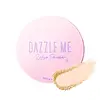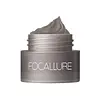What's inside
What's inside
 Key Ingredients
Key Ingredients

 Benefits
Benefits

 Concerns
Concerns

 Ingredients Side-by-side
Ingredients Side-by-side

Corn Starch Modified
AbsorbentSilica
AbrasiveSynthetic Fluorphlogopite
Mica
Cosmetic ColorantPhenoxyethanol
PreservativeMagnesium Myristate
Dimethicone
EmollientTocopheryl Acetate
AntioxidantTriethoxycaprylylsilane
Titanium Dioxide
Cosmetic ColorantPhenyl Trimethicone
Skin ConditioningParfum
MaskingAluminum Hydroxide
EmollientEthylhexylglycerin
Skin ConditioningCyclopentasiloxane
EmollientPolymethylsilsesquioxane
Hydrated Silica
AbrasiveHydrogen Dimethicone
Ascorbic Acid
AntioxidantArbutin
AntioxidantEthylhexyl Palmitate
EmollientSaccharomyces/Rice Ferment Filtrate
Skin ConditioningWater
Skin ConditioningHydrogenated Polyisobutene
EmollientGlycerin
HumectantHydrogenated Lecithin
EmulsifyingCalendula Officinalis Flower Extract
MaskingCeramide NP
Skin ConditioningCaprylyl Glycol
EmollientPropylene Glycol
HumectantChrysanthellum Indicum Extract
Skin ConditioningButylene Glycol
HumectantTrihydroxystearin
Skin Conditioning1,2-Hexanediol
Skin ConditioningSodium Hyaluronate
HumectantGlucomannan
Skin ConditioningCI 77891
Cosmetic ColorantCI 77492
Cosmetic ColorantCI 77491
Cosmetic ColorantCorn Starch Modified, Silica, Synthetic Fluorphlogopite, Mica, Phenoxyethanol, Magnesium Myristate, Dimethicone, Tocopheryl Acetate, Triethoxycaprylylsilane, Titanium Dioxide, Phenyl Trimethicone, Parfum, Aluminum Hydroxide, Ethylhexylglycerin, Cyclopentasiloxane, Polymethylsilsesquioxane, Hydrated Silica, Hydrogen Dimethicone, Ascorbic Acid, Arbutin, Ethylhexyl Palmitate, Saccharomyces/Rice Ferment Filtrate, Water, Hydrogenated Polyisobutene, Glycerin, Hydrogenated Lecithin, Calendula Officinalis Flower Extract, Ceramide NP, Caprylyl Glycol, Propylene Glycol, Chrysanthellum Indicum Extract, Butylene Glycol, Trihydroxystearin, 1,2-Hexanediol, Sodium Hyaluronate, Glucomannan, CI 77891, CI 77492, CI 77491
Water
Skin ConditioningIsododecane
EmollientKaolin
AbrasivePolyglyceryl-3 Methylglucose Distearate
EmulsifyingEthylhexyl Palmitate
EmollientCetearyl Alcohol
EmollientPalmitic Acid
EmollientGlycerin
HumectantButylene Glycol
HumectantDimethicone
EmollientMacadamia Integrifolia Seed Oil
Skin ConditioningOlea Europaea Fruit Oil
MaskingCI 77891
Cosmetic ColorantGlyceryl Stearate
EmollientStearic Acid
CleansingPEG-100 Stearate
1,2-Hexanediol
Skin ConditioningSodium Polyacrylate
AbsorbentXanthan Gum
EmulsifyingPhenoxyethanol
PreservativeC13-14 Isoparaffin
EmollientCI 77492
Cosmetic ColorantChlorphenesin
AntimicrobialCI 77499
Cosmetic ColorantC11-13 Isoparaffin
SolventCI 77288
Cosmetic ColorantBisabolol
MaskingDipotassium Glycyrrhizate
HumectantMelaleuca Alternifolia Leaf
AbrasiveWater, Isododecane, Kaolin, Polyglyceryl-3 Methylglucose Distearate, Ethylhexyl Palmitate, Cetearyl Alcohol, Palmitic Acid, Glycerin, Butylene Glycol, Dimethicone, Macadamia Integrifolia Seed Oil, Olea Europaea Fruit Oil, CI 77891, Glyceryl Stearate, Stearic Acid, PEG-100 Stearate, 1,2-Hexanediol, Sodium Polyacrylate, Xanthan Gum, Phenoxyethanol, C13-14 Isoparaffin, CI 77492, Chlorphenesin, CI 77499, C11-13 Isoparaffin, CI 77288, Bisabolol, Dipotassium Glycyrrhizate, Melaleuca Alternifolia Leaf
Ingredients Explained
These ingredients are found in both products.
Ingredients higher up in an ingredient list are typically present in a larger amount.
1,2-Hexanediol is a synthetic liquid and another multi-functional powerhouse.
It is a:
- Humectant, drawing moisture into the skin
- Emollient, helping to soften skin
- Solvent, dispersing and stabilizing formulas
- Preservative booster, enhancing the antimicrobial activity of other preservatives
Butylene Glycol (or BG) is used within cosmetic products for a few different reasons:
Overall, Butylene Glycol is a safe and well-rounded ingredient that works well with other ingredients.
Though this ingredient works well with most skin types, some people with sensitive skin may experience a reaction such as allergic rashes, closed comedones, or itchiness.
Learn more about Butylene GlycolCi 77492 is also hydrated iron III oxide. It's sole purpose is to give a yellow hue to products.
Iron III oxides are classified as inorganic chemicals for coloring.
Synthetically created Ci 77492 is considered safer than those naturally found. This is because the synthetically created version may contain less impurities. Iron oxides are generally non-toxic and non-allergenic.
Learn more about CI 77492Ci 77891 is a white pigment from Titanium dioxide. It is naturally found in minerals such as rutile and ilmenite.
It's main function is to add a white color to cosmetics. It can also be mixed with other colors to create different shades.
Ci 77891 is commonly found in sunscreens due to its ability to block UV rays.
Learn more about CI 77891Dimethicone is a type of synthetic silicone created from natural materials such as quartz.
What it does:
Dimethicone comes in different viscosities:
Depending on the viscosity, dimethicone has different properties.
Ingredients lists don't always show which type is used, so we recommend reaching out to the brand if you have questions about the viscosity.
This ingredient is unlikely to cause irritation because it does not get absorbed into skin. However, people with silicone allergies should be careful about using this ingredient.
Note: Dimethicone may contribute to pilling. This is because it is not oil or water soluble, so pilling may occur when layered with products. When mixed with heavy oils in a formula, the outcome is also quite greasy.
Learn more about DimethiconeEthylhexyl Palmitate, also known as octyl palmitate, is created from 2-ethylhexyl alcohol and palmitic acid. It is a fatty acid ester.
The fatty acid content of Ethylhexyl Palmitate makes it an emollient. Emollients help soften and hydrate your skin by trapping moisture within.
Ethylhexyl Palmitate is also used to help improve the texture of cosmetics. It helps other ingredient dissolve in products and help disperse ingredients more evenly.
You'll likely find this ingredient in sunscreen, as it is often used to mix UV-blocking ingredients such as avobenzone and ethylhexyl triazone.
It can also help stabilize the fragrances in a product as a fragrance fixative.
Ethylhexyl Palmitate can be used to substitute mineral oil.
Due to its high fatty acid content, it may not be fungal-acne safe.
Learn more about Ethylhexyl PalmitateGlycerin is already naturally found in your skin. It helps moisturize and protect your skin.
A study from 2016 found glycerin to be more effective as a humectant than AHAs and hyaluronic acid.
As a humectant, it helps the skin stay hydrated by pulling moisture to your skin. The low molecular weight of glycerin allows it to pull moisture into the deeper layers of your skin.
Hydrated skin improves your skin barrier; Your skin barrier helps protect against irritants and bacteria.
Glycerin has also been found to have antimicrobial and antiviral properties. Due to these properties, glycerin is often used in wound and burn treatments.
In cosmetics, glycerin is usually derived from plants such as soybean or palm. However, it can also be sourced from animals, such as tallow or animal fat.
This ingredient is organic, colorless, odorless, and non-toxic.
Glycerin is the name for this ingredient in American English. British English uses Glycerol/Glycerine.
Learn more about GlycerinPhenoxyethanol is a preservative that has germicide, antimicrobial, and aromatic properties. Studies show that phenoxyethanol can prevent microbial growth. By itself, it has a scent that is similar to that of a rose.
It's often used in formulations along with Caprylyl Glycol to preserve the shelf life of products.
Water. It's the most common cosmetic ingredient of all. You'll usually see it at the top of ingredient lists, meaning that it makes up the largest part of the product.
So why is it so popular? Water most often acts as a solvent - this means that it helps dissolve other ingredients into the formulation.
You'll also recognize water as that liquid we all need to stay alive. If you see this, drink a glass of water. Stay hydrated!
Learn more about Water